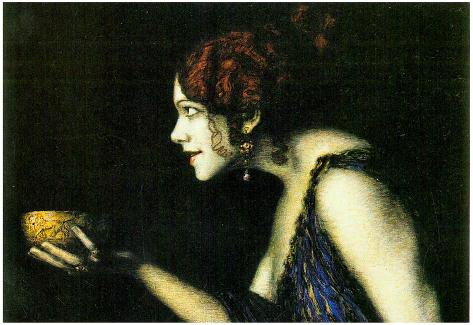
To request a higher resolution file of this image, please submit an online request. Find an in-depth biography, exhibitions, original artworks for sale, the latest news, and sold auction prices. View Franz von Stuck’s 1,184 artworks on artnet. Modern and Contemporary Harvard Art Museums encourage the use of images found on this website for personal, noncommercial use, including educational and scholarly purposes. Franz von Stuck was a German decorative painter and sculptor, best known for his Symbolist imagery and close attention to describing three-dimensional forms. Harvard Art Museums/Busch-Reisinger Museum, Gift of Naomi Jackson Groves Original Language Title: Tilla Durieux als "Circe" Tilla Durieux as "Circe", reproduction of the painting by Franz von Stuck After Franz von Stuck, German (Tettenweis, near Passau, Germany 1863 - 1928 Munich, Germany) Title: Tilla Durieux as Circe, reproduction of the painting.

He is buried in the Munich Waldfriedhof next to his wife Mary.This object does not yet have a description.Īfter Franz von Stuck, German (Tettenweis, near Passau, Germany 1863 - 1928 Munich, Germany)

His work was also part of the sculpture event in the art competition at the 1928 Summer Olympics.įranz von Stuck died on August 30, 1928, in Munich his funeral address memorialized him as "the last prince of art of Munich's great days". He was a member of the International Society of Sculptors, Painters and Gravers. His students over the years included Paul Klee, Hans Purrmann, Wassily Kandinsky, Alf Bayrle and Josef Albers. He continued to be well respected among young artists as professor at the Munich Academy, even after his artistic styles became unfashionable. Having attained a high public profile by this time, Stuck was ennobled on December 9, 1905, and would receive further public honours from around Europe during the remainder of his life. His designs for the villa included everything from layout to interior decorations for his furniture Stuck received another gold medal at the 1900 Paris World Exposition. In 1897 Stuck married an American widow, Mary Lindpainter, and began work designing his own residence and studio, the Villa Stuck. In 1895, he began teaching painting at the Munich Academy. Also during 1893, Stuck was awarded a gold medal for painting at the World's Columbian Exposition in Chicago, and was appointed to a royal professorship. The next year he won further acclaim with the critical and public success of what is now his best known work, the painting The Sin. In 1892 Stuck co-founded the Munich Secession, and also executed his first sculpture, Athlete. In 1889 he exhibited his first paintings at the Munich Glass Palace, winning a gold medal for The Guardian of Paradise. Franz von Stuck was a German decorative painter and sculptor, best known for his Symbolist imagery and close attention to describing three-dimensional forms. He first became well known by cartoons for Fliegende Blätter, and vignette designs for programmes and book decoration. From 1881 to 1885 Stuck attended the Munich Academy. To begin his artistic education he relocated in 1878 to Munich, where he would settle for life. In 1906, Stuck was awarded the Order of Merit of the Bavarian Crown and was henceforth known as Franz Ritter von Stuck.īorn at Tettenweis near Passau, Stuck displayed an affinity for drawing and caricature from an early age. Stuck was best known for his paintings of ancient egyptian mythology receiving substantial critical acclaim with The Sin in 1892. Franz von Stuck was a German painter, sculptor, printmaker, and architect.


 0 kommentar(er)
0 kommentar(er)
